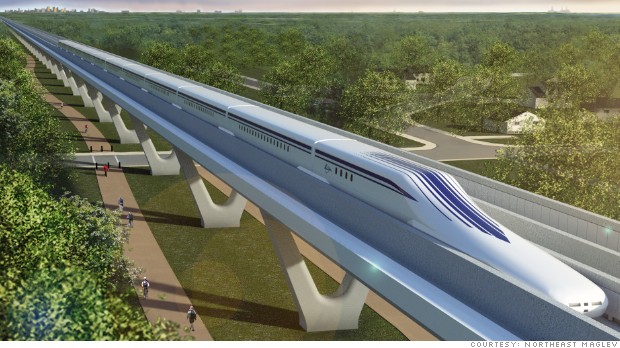Bullet trains running at 300 miles per hour between
Boston and DC, and between
San Francisco and
LA are amazing ideas. People could live anywhere along the corridor and go to work anywhere else along the corridor. That is an amazing concept. There is not a better
affordable housing idea than this in NYC. This affordable housing idea is fully scalable. This is affordable housing at market rates. Go figure.
There is an even better idea: gigabit broadband. Taking gigabit broadband to all homes and offices in NYC and the tri-state area will turn many commuters into telecommuters. That will lessen the traffic. And gigabit broadband is much, much cheaper than bullet trains.
Floating train could whisk you from D.C. to N.Y. in an hour
"You could live in Baltimore and commute to New York City faster than you could from Connecticut" ...... "It changes real estate prices, how people live, where they work. It really changes the world." ..... The magnets both lift the train and propel it forward, with the reduced friction being responsible for the train's super speed. .... While it sounds like the stuff of sci-fi, the technology itself has actually been around for over a century. ..... But it's expensive. Northeast Maglev estimates the New York to D.C. route could cost over $100 billion. Much of the money would be spent on tunnels and elevated track necessary in such a densely populated area -- possibly tunneling under cities and then running over or adjacent to Interstate 95 in more rural areas. ...... A second high speed proposal from the private sector may soon break ground in Texas....... This plan calls for a more traditional bullet train (think wheels and rail, but with speeds over 200 mph) running from Dallas to Houston. The trip could be made in 90 minutes as opposed to the three-and-a-half hours it currently takes by car or one hour by plane. The group promoting it -- Texas Central Railway -- says fares would be similar to those of a flight, but minus the hassle of getting to the airport and checking in....... What makes this project more likely is that it's using a technology that's been in commercial operation for over 50 years, is connecting two heavily populated areas over an empty, flat middle ground, and has a relatively modest price tag of $10 billion.













